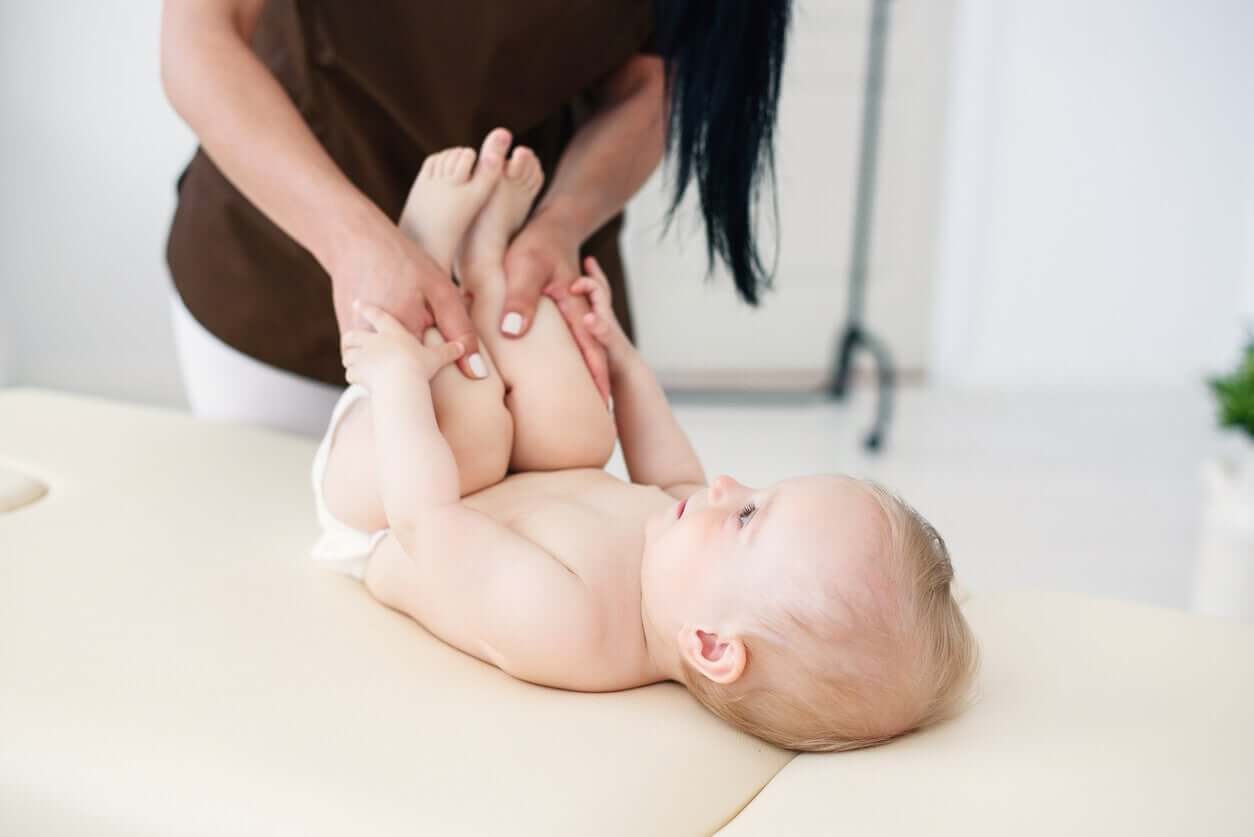Muscle Stretching in Babies: Exercises and Benefits


Written and verified by degree in physical education and sports Andrés Felipe Cardona Lenis
Muscle stretching is essential for the human body. In turn, the constant performance of this exercise allows muscle development and reduces the chances of injury. This practice is even recommended from the time children are babies. Physical activity shouldn’t be limited by age but should be adapted to the conditions of each person. In this sense, one of the recommendations for muscle stretching in babies is that it should be performed by parents or supervised by them.
Muscle stretching in babies
The younger the baby, the more complex it will be for them to engage in physical activity. In general, during the first months of life, little ones don’t carry out physical activity in a planned way.
However, the first year of life is a fundamental stage for a child’s psychomotor development. And therefore, as a mother, you should focus on early stimulation and the importance of body stretching for them.
For all the above reasons, today we’re going to teach you some muscle stretching exercises for babies that will be of great help. Take note!
Implement these muscle stretching exercises for babies!

Young babies make certain movements through the reflex arcs of the body. This way, little by little, they associate with the environment and learn to cope with motor skills.
Despite this, muscle stretching in babies is much more complex than this and stands out as a third-party-directed activity. In this case, the mother or father.
It should be mentioned that this exercise isn’t the equivalent of the occasional stretching of the little ones, which is usually unexpected and sporadic. On the contrary, these exercises are programmed, specific, and passive, as they require the action of another person.
Take note of the following suggestions!
1. Leg stretch
In order to stretch your baby’s legs, make sure they’re lying on their back.
From this position, hold their feet with each hand and begin to stimulate joint mobility in your hips, knees, and ankles.
Then, bend both legs from the knee joint, one at a time. Try to bring them towards the chest, in a firm movement but without exerting excessive force. When you finish with one leg, do the same with the other.
Later, extend both legs and let them rest. Take one of the baby’s feet and performs movements of flexion and extension and finally, hold that position for a few seconds.
2. Arms stretch
The arms should also be stimulated and stretched in a similar way to the legs.
To perform stretching exercises in babies, you must make sure that they’re lying on their back on a firm and comfortable pillow.
To start, take their right arm in your hand and bring it to the side and slightly back. Hold the position for a few seconds. In order to improve the stretch, we recommend that you support your other hand at the level of his chest.
When you finish with the right arm, perform the exact same exercise with the left arm.
To stretch both arms, you must hold them with your hands, bring them to the front, and cross them with each other. Maintain this position for a few seconds and return to the starting position, so that the baby can rest.
Benefits of muscle stretching in babies
There are many muscle stretching exercises and each segment of the body can and should be stretched. However, the examples presented above refer to the main structures of the body: The arms and legs.
Ideally, you should implement these examples, as well as other stretching exercises, on a regular basis throughout the week. This will support the following aspects of the baby’s well-being.
Prevention of contractures
Structures that contract cause discomfort and problems in the body. In babies, a contracted muscle can lead to malformations or similar conditions. For this reason, stretching and recurrent stimulation can avoid these types of problems or improve existing ones.
Disease treatment
Muscle stretching in babies also contributes to the treatment of various diseases. According to a publication from the University of Valladolid, this type of exercise is very effective in the treatment of congenital muscular torticollis.
At the same time, according to a study published in the journal of Neurology, physiotherapy (which includes stretching exercises) applied to children with brachial palsy favors their rehabilitation.
Building muscle tone
Muscle tone is the permanent slight tension of the muscles to achieve body support and posture.
From an early age in life, muscles must be stimulated and strengthened. Through these exercises, it’s possible to improve muscle tone throughout the body. In fact, continuous stretching offers your baby the ability to hold long postures.
The improvement of physical abilities
Performing muscle stretching and physical stimulation exercises contributes to the strengthening of different physical capacities. Although these types of skills develop throughout life, children are very sensitive in this regard.

Muscle stretching in babies, don’t do it without medical approval
Muscle stretching has a number of benefits for your baby. Despite this, all the exercises you plan to implement in your child must be endorsed by a pediatrician.
Remember that all children are unique and some health conditions can involve contraindications when stretching.
Muscle stretching is essential for the human body. In turn, the constant performance of this exercise allows muscle development and reduces the chances of injury. This practice is even recommended from the time children are babies. Physical activity shouldn’t be limited by age but should be adapted to the conditions of each person. In this sense, one of the recommendations for muscle stretching in babies is that it should be performed by parents or supervised by them.
Muscle stretching in babies
The younger the baby, the more complex it will be for them to engage in physical activity. In general, during the first months of life, little ones don’t carry out physical activity in a planned way.
However, the first year of life is a fundamental stage for a child’s psychomotor development. And therefore, as a mother, you should focus on early stimulation and the importance of body stretching for them.
For all the above reasons, today we’re going to teach you some muscle stretching exercises for babies that will be of great help. Take note!
Implement these muscle stretching exercises for babies!

Young babies make certain movements through the reflex arcs of the body. This way, little by little, they associate with the environment and learn to cope with motor skills.
Despite this, muscle stretching in babies is much more complex than this and stands out as a third-party-directed activity. In this case, the mother or father.
It should be mentioned that this exercise isn’t the equivalent of the occasional stretching of the little ones, which is usually unexpected and sporadic. On the contrary, these exercises are programmed, specific, and passive, as they require the action of another person.
Take note of the following suggestions!
1. Leg stretch
In order to stretch your baby’s legs, make sure they’re lying on their back.
From this position, hold their feet with each hand and begin to stimulate joint mobility in your hips, knees, and ankles.
Then, bend both legs from the knee joint, one at a time. Try to bring them towards the chest, in a firm movement but without exerting excessive force. When you finish with one leg, do the same with the other.
Later, extend both legs and let them rest. Take one of the baby’s feet and performs movements of flexion and extension and finally, hold that position for a few seconds.
2. Arms stretch
The arms should also be stimulated and stretched in a similar way to the legs.
To perform stretching exercises in babies, you must make sure that they’re lying on their back on a firm and comfortable pillow.
To start, take their right arm in your hand and bring it to the side and slightly back. Hold the position for a few seconds. In order to improve the stretch, we recommend that you support your other hand at the level of his chest.
When you finish with the right arm, perform the exact same exercise with the left arm.
To stretch both arms, you must hold them with your hands, bring them to the front, and cross them with each other. Maintain this position for a few seconds and return to the starting position, so that the baby can rest.
Benefits of muscle stretching in babies
There are many muscle stretching exercises and each segment of the body can and should be stretched. However, the examples presented above refer to the main structures of the body: The arms and legs.
Ideally, you should implement these examples, as well as other stretching exercises, on a regular basis throughout the week. This will support the following aspects of the baby’s well-being.
Prevention of contractures
Structures that contract cause discomfort and problems in the body. In babies, a contracted muscle can lead to malformations or similar conditions. For this reason, stretching and recurrent stimulation can avoid these types of problems or improve existing ones.
Disease treatment
Muscle stretching in babies also contributes to the treatment of various diseases. According to a publication from the University of Valladolid, this type of exercise is very effective in the treatment of congenital muscular torticollis.
At the same time, according to a study published in the journal of Neurology, physiotherapy (which includes stretching exercises) applied to children with brachial palsy favors their rehabilitation.
Building muscle tone
Muscle tone is the permanent slight tension of the muscles to achieve body support and posture.
From an early age in life, muscles must be stimulated and strengthened. Through these exercises, it’s possible to improve muscle tone throughout the body. In fact, continuous stretching offers your baby the ability to hold long postures.
The improvement of physical abilities
Performing muscle stretching and physical stimulation exercises contributes to the strengthening of different physical capacities. Although these types of skills develop throughout life, children are very sensitive in this regard.

Muscle stretching in babies, don’t do it without medical approval
Muscle stretching has a number of benefits for your baby. Despite this, all the exercises you plan to implement in your child must be endorsed by a pediatrician.
Remember that all children are unique and some health conditions can involve contraindications when stretching.
All cited sources were thoroughly reviewed by our team to ensure their quality, reliability, currency, and validity. The bibliography of this article was considered reliable and of academic or scientific accuracy.
- Arco reflejo. (2021). Rescatado de la web Apuntes Neuroanatomía UFRO. Disponible en: https://www.med.ufro.cl/neuroanatomia/archivos/13_sistematizacion_archivos/Page310.htm
- Alejandro Medina Salas. (2002). Revista Mexicana de Medicina Física y Rehabilitación. La estimulación temprana. Disponible en: https://www.medigraphic.com/pdfs/fisica/mf-2002/mf02-2_4i.pdf
- Elsa García Domínguez. (2016). Universidad de Valladolid. Eficacia de los estiramientos como tratamiento de la tortícolis muscular congénita. Disponible en: https://uvadoc.uva.es/bitstream/handle/10324/15824/TFG-O%20697.pdf;jsessionid=764A504C069C7A530211FAA1FEE52085?sequence=1
- R. Palomo-Carrión, R. Sánchez. (2020). Revista de Neurología. Fisioterapia aplicada en la extremidad superior a niños de 0 a 10 años con parálisis braquial obstétrica: revisión sistemática. Disponible en: https://www.neurologia.com/articulo/2020029
This text is provided for informational purposes only and does not replace consultation with a professional. If in doubt, consult your specialist.








